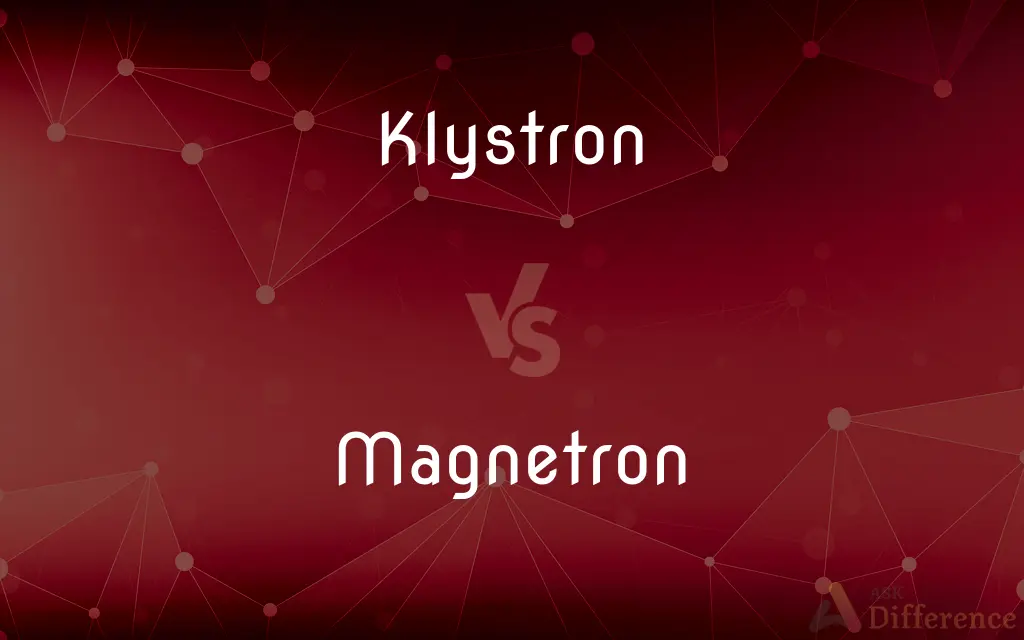Klystron vs. Magnetron — What's the Difference?
By Urooj Arif & Fiza Rafique — Updated on March 13, 2024
Klystron amplifies RF signals with high power and precision, used in radar and communication, while Magnetron generates microwaves for radar and ovens, focusing on power over precision.

Difference Between Klystron and Magnetron
Table of Contents
ADVERTISEMENT
Key Differences
A klystron is a specialized vacuum tube used to amplify high-frequency radio waves, particularly useful in radar systems, satellite communications, and as oscillators in microwave devices. It operates by modulating the velocity of an electron beam through a series of cavities, which then amplifies the input signal. On the other hand, a magnetron is a type of vacuum tube that generates microwaves using the interaction of a stream of electrons with a magnetic field. It is widely used in microwave ovens and some radar applications, focusing on generating powerful microwaves rather than amplifying signals.
Klystrons are known for their ability to produce amplifications with high gain and bandwidth, making them ideal for applications requiring precise control over the frequency and phase of the RF signal. This precision is crucial in applications such as broadcasting and particle accelerators. Magnetrons, while less precise in controlling frequency and phase, excel in generating high-power microwave energy efficiently, which is why they are preferred in cooking appliances and some industrial applications.
The design and operation of a klystron allow for continuous wave output, which can be finely tuned for specific applications. This continuous wave output is essential in systems that require stable and controllable signals, such as in scientific research. Conversely, magnetrons produce pulsed microwaves, which are more suitable for applications like radar systems where short, high-power bursts of microwaves are needed to detect objects at long distances.
Another key difference lies in their applications and efficiency. Klystrons, being more complex and expensive to manufacture, are typically used in specialized fields where their high performance and signal fidelity are necessary. Magnetrons, being simpler and more cost-effective, are ubiquitous in household and industrial microwave ovens, as well as in certain types of radar systems where their efficiency in converting electricity into microwave energy is valued.
While both klystrons and magnetrons are critical in the realm of microwave technology, their usage and functionality diverge significantly. Klystrons are favored in professional and scientific applications for their signal clarity and amplification capabilities, whereas magnetrons dominate in applications requiring the generation of high-power microwaves, demonstrating a clear distinction in their roles across different technologies.
ADVERTISEMENT
Comparison Chart
Function
Amplifies RF signals with high precision
Generates microwaves, focusing on power
Applications
Radar, satellite communications, particle accelerators
Microwave ovens, some radar systems
Signal Type
Continuous wave, high gain, and bandwidth for precise control
Pulsed microwaves, high power
Efficiency & Cost
More complex and expensive, used in specialized applications
Simpler, cost-effective, widely used in commercial and domestic appliances
Operation Principle
Modulates velocity of electron beam through cavities to amplify signals
Generates microwaves through electron interaction with a magnetic field
Compare with Definitions
Klystron
A vacuum tube that amplifies high-frequency radio waves.
The klystron is crucial for the radar system’s accuracy.
Magnetron
A vacuum tube that generates microwaves using a magnetic field.
The microwave oven’s heating capability comes from the magnetron.
Klystron
Produces continuous wave output for stable signals.
The klystron provided the continuous wave needed for the experiment.
Magnetron
Produces pulsed microwaves, suitable for radar detection.
The radar system employs a magnetron to emit powerful microwaves.
Klystron
Known for its high gain and bandwidth capabilities.
They used a klystron to ensure the satellite communication was clear.
Magnetron
Used widely in commercial and domestic appliances.
Every household microwave oven contains a magnetron.
Klystron
Used in specialized applications like particle accelerators.
The particle accelerator's efficiency relies on the klystron's performance.
Magnetron
Simpler and more cost-effective than klystrons.
Manufacturers prefer magnetrons for microwave ovens due to their cost-effectiveness.
Klystron
More complex and expensive than magnetrons.
The research lab invested in a klystron for its advanced projects.
Magnetron
Efficiently converts electricity into high-power microwaves.
The magnetron is valued for its power efficiency in industrial applications.
Klystron
An electron tube used to amplify or generate ultrahigh frequency by means of velocity modulation.
Magnetron
A microwave tube in which electrons generated from a heated cathode are affected by magnetic and electric fields in such a way as to produce microwave radiation used in radar and in microwave ovens.
Klystron
(physics) an electron tube used to amplify microwave-frequency electromagnetic radiation.
Magnetron
(physics) a device in which electrons are made to resonate in a specially shaped chamber and thus produce microwave radiation; used in radar, and in microwave ovens
Klystron
A klystron is a specialized linear-beam vacuum tube, invented in 1937 by American electrical engineers Russell and Sigurd Varian, which is used as an amplifier for high radio frequencies, from UHF up into the microwave range. Low-power klystrons are used as oscillators in terrestrial microwave relay communications links, while high-power klystrons are used as output tubes in UHF television transmitters, satellite communication, radar transmitters, and to generate the drive power for modern particle accelerators.
Magnetron
A diode vacuum tube in which the flow of electrons from a central cathode to a cylindrical anode is controlled by crossed magnetic and electric fields; used mainly in microwave oscillators.
Klystron
An electron tube used to generate or amplify electromagnetic radiation in the microwave region by velocity modulation
Magnetron
A diode vacuum tube in which the flow of electrons from a central cathode to a cylindrical anode is controlled by crossed magnetic and electric fields; used mainly in microwave oscillators
Common Curiosities
What is the primary function of a klystron?
A klystron amplifies high-frequency radio waves with precision.
Are klystrons used in microwave ovens?
No, klystrons are not typically used in microwave ovens; magnetrons are used instead.
Why is a magnetron preferred in microwave ovens?
Magnetrons are preferred for their efficiency in generating high-power microwaves and cost-effectiveness.
Which is more expensive, a klystron or a magnetron?
Klystrons are generally more expensive due to their complexity and specialized application.
How does a magnetron generate microwaves?
A magnetron generates microwaves by interacting electrons with a magnetic field.
What applications require a klystron?
Klystrons are used in radar, satellite communications, and scientific research.
What role does a magnetron play in a microwave oven?
The magnetron generates the microwaves that cook food in a microwave oven.
Is a magnetron suitable for radar systems?
Yes, magnetrons are suitable for some radar systems, especially for their high-power pulsed microwave output.
Why are continuous wave outputs important in some applications?
Continuous wave outputs provide stable and controllable signals, crucial for scientific research and communication systems.
Can klystrons generate microwaves?
Klystrons can generate microwaves but are primarily used to amplify RF signals.
What distinguishes a klystron's operation from a magnetron's?
Klystrons amplify signals via electron beam modulation, while magnetrons generate microwaves through magnetic interaction.
How do the costs of klystrons and magnetrons compare?
Klystrons are more complex and expensive, while magnetrons are more cost-effective and widely used in consumer products.
What makes magnetrons efficient in power conversion?
Magnetrons efficiently convert electrical energy into microwave energy, making them ideal for cooking and heating applications.
How do klystrons contribute to satellite communications?
Klystrons amplify signals for clear and long-distance satellite communications.
Can klystrons be used in particle accelerators?
Yes, klystrons are used in particle accelerators to amplify RF signals for accelerating particles.
Share Your Discovery

Previous Comparison
Vacation vs. Vacay
Next Comparison
Earwig vs. CentipedeAuthor Spotlight
Written by
Urooj ArifUrooj is a skilled content writer at Ask Difference, known for her exceptional ability to simplify complex topics into engaging and informative content. With a passion for research and a flair for clear, concise writing, she consistently delivers articles that resonate with our diverse audience.
Co-written by
Fiza RafiqueFiza Rafique is a skilled content writer at AskDifference.com, where she meticulously refines and enhances written pieces. Drawing from her vast editorial expertise, Fiza ensures clarity, accuracy, and precision in every article. Passionate about language, she continually seeks to elevate the quality of content for readers worldwide.














































